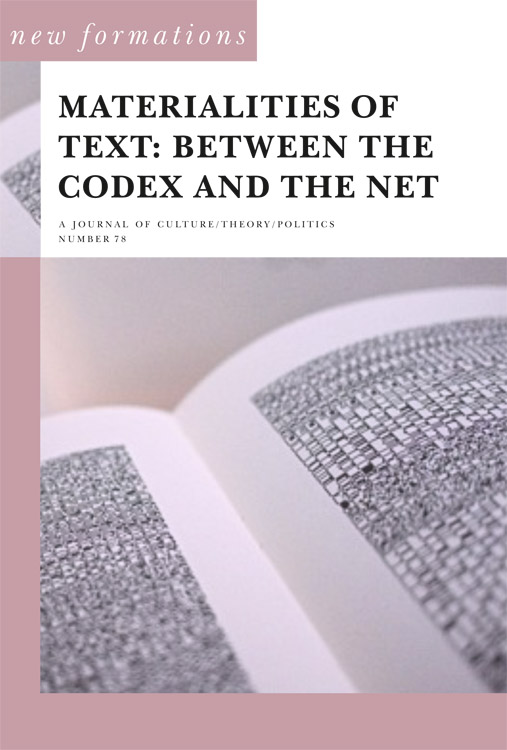New Formations, 78: Materialities of Text: Between the Codex and the Net (2013)
Filed under journal | Tags: · archive, artists book, book, digital humanities, digital library, library, materiality, publishing, reading, shadow library, text

“The cultural authority of the codex form of the book appears to be in a process of displacement ensuing from the rise of on-line digital media. The traditional material structures of the book – its physical forms and its institutional forms of production, circulation, and preservation – are often seen as being subject to dematerialisation; evaporating in the transitory appearances of the digital screen and in the proliferation of new systems of production. However, this issue of New Formations makes the case that the present historical juncture should be understood as a mixed media milieu, in which traditional and digital forms of writing and publishing coalesce and conflict in a complex array of textual materialities.
Such materialities of text are at once sites of political and aesthetic experimentation, and of intense capitalization, intersecting features which are approached in the articles collected here through a broad range of theoretical and empirical themes: diagrammatic writing; the material reading formations of a best-seller novel; grey literature in the institutions of cultural studies; Black Twitter; the politics of Open Access and the artists’ book; digital humanities and its political problematics; the bibliopolitics of the passport; and the political and aesthetic forms of independent publishing.”
Contributions by Richard Burt, Sanjay Sharma, Hanna Kuusela, Johanna Drucker, Ted Striphas and Mark Hayward, Sas Mays, Janneke Adema and Gary Hall, Jodi Dean, Sean Dockray, Alessandro Ludovico, Pauline van Mourik, Broekman, Nicholas Thoburn and Dmitry Vilensky.
Edited and with an Introduction by Sas Mays and Nicholas Thoburn
Publisher Lawrence & Wishart, Summer 2013
ISSN 0950-2378
207 pages
Review: Janneke Adema (2013).
Comment (0)Johanna Drucker: Alphabetic Labyrinth: The Letters in History and Imagination (1995–) [EN, SR]
Filed under book | Tags: · alphabet, book, graphic design, text, typography

“The alphabet is at once familiar and mysterious. Its letters have been the object of speculation since their invention almost four thousand years ago; the symbols represent sounds, yet they exist in their own right, often invested with quasi-magical power. Johanna Drucker, who teaches art history at Yale University, examines the imaginative and idiosyncratic ways in which the letters of the alphabet have been assigned value in political, spiritual, or religious belief systems over two millennia. The first book to explore fully this colorful, poetic, and frequently eccentric realm, The Alphabetic Labyrinth is richly complemented by images that have rarely or never before been reproduced. Drawing on a wide variety of little-known sources, both literary and artistic, the author adds a new and exciting chapter to the history of ideas which will prove fascinating to cultural historians, art historians, and anyone interested in the history of writing.”
Publisher Thames and Hudson, London, 1995
ISBN 0500016089, 9780500016084
315 pages
Reviews: Ellen Lupton (Eye, 1995), Cliff Pickover (Leonardo, 1999).
The Alphabetic Labyrinth (English, 1995, 18 MB)
Alfabetski lavirint (Serbian, trans. Branislav Kovačević, 2006)
Algolit: Data Workers (2019) [English/French]
Filed under book, catalogue, wiki book | Tags: · algorithm, artificial intelligence, data, literature, machine learning, natural language processing, poetry, text

“Companies create artificial intelligence (AI) systems to serve, entertain, record and learn about humans. The work of these machinic entities is usually hidden behind interfaces and patents. In the exhibition, algorithmic storytellers left their invisible underworld to become interlocutors.
The data workers operate in different collectives. Each collective represents a stage in the design process of a machine learning model: there are the Writers, the Cleaners, the Informants, the Readers, the Learners and the Oracles. The boundaries between these collectives are not fixed; they are porous and permeable. At times, Oracles are also Writers. At other times Readers are also Oracles. Robots voice experimental literature, while algorithmic models read data, turn words into numbers, make calculations that define patterns and are able to endlessly process new texts ever after.
The exhibition foregrounded data workers who impact our daily lives, but are either hard to grasp and imagine or removed from the imagination altogether. It connected stories about algorithms in mainstream media to the storytelling that is found in technical manuals and academic papers. Robots were invited to engage in dialogue with human visitors and vice versa. In this way we might understand our respective reasonings, demystify each other’s behaviour, encounter multiple personalities, and value our collective labour.
It was also a tribute to the many machines that Paul Otlet and Henri La Fontaine imagined for their Mundaneum, showing their potential but also their limits.”
Texts: Cristina Cochior, Sarah Garcin, Gijs de Heij, An Mertens, François Zajéga, Louise Dekeuleneer, Florian Van de Weyer, Laetitia Trozzi, Rémi Forte, Guillaume Slizewicz.
Publisher Constant, Brussels, 2019
Free Art License
52 pages
PDF, PDF, HTML (English)
PDF, PDF, HTML (French)
Git

